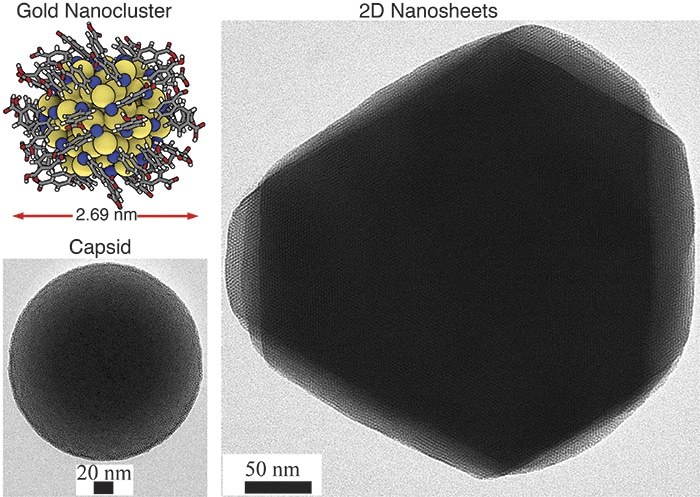Jan 16 2017
 2D hexagonal sheet-like and 3D capsid structures based on atomically precise gold nanoclusters as guided by hydrogen bonding between the ligands. The inset in the top left corner shows the atomic structure of one gold nanocluster. Credit: Academy of Finland
2D hexagonal sheet-like and 3D capsid structures based on atomically precise gold nanoclusters as guided by hydrogen bonding between the ligands. The inset in the top left corner shows the atomic structure of one gold nanocluster. Credit: Academy of Finland
Self-assembly of matter is one of the basic principles of nature, monitoring the growth of larger ordered and functional systems from smaller building blocks. It is possible to observe self-assembly in all length scales from molecules to galaxies.
Researchers at the Nanoscience Centre of the University of Jyväskylä and the HYBER Centre of Excellence of Aalto University in Finland have recently reported a novel discovery of self-assembling 2D and 3D materials developed from extremely small gold nanoclusters of only a couple of nanometres in size, each made up of a surface layer of 44 thiol molecules and 102 gold atoms.
This research, funded by the Academy of Finland and the European Research Council, has been featured in Angewandte Chemie, a globally leading journal in chemistry.
A group headed by Roger D Kornberg at Stanford University was the first to resolve the atomic structure of the 102-atom gold nanocluster in 2007. Since then, a number of further studies of its properties have been conducted in the Jyväskylä Nanoscience Centre, where it has further been used for electron microscopy imaging of virus structures.
The nanocluster’s thiol surface has an increasing number of acidic groups that can develop directed hydrogen bonds to neighboring nanoclusters and also initiate directed self-assembly.
The self-assembly of gold nanoclusters was performed in a water-methanol mixture resulting in the production of two specifically different superstructures imaged in a high-resolution electron microscope at Aalto University. 2D hexagonally ordered layers of gold nanoclusters were stacked together in one of the structures, where every single layer was just one nanocluster thick.
Altering the synthesis conditions helped observing 3D spherical, hollow capsid structures, where the thickness of the capsid wall matches again to just one nanocluster size.
Even as the details of the formation mechanisms of these superstructures guarantee further systemic investigations, the preliminary observations open a number of new views into synthetically made self-assembling nanomaterials.
Today, we know of several tens of different types of atomistically precise gold nanoclusters, and I believe they can exhibit a wide variety of self-assembling growth patterns that could produce a range of new meta-materials. In biology, typical examples of self-assembling functional systems are viruses and vesicles. Biological self-assembled structures can also be de-assembled by gentle changes in the surrounding biochemical conditions. It’ll be of great interest to see whether these gold-based materials can be de-assembled and then re-assembled to different structures by changing something in the chemistry of the surrounding solvent.
Hannu Häkkinen, Professor, Academy of Finland
“The free-standing two-dimensional nanosheets will bring opportunities towards new-generation functional materials, and the hollow capsids will pave the way for highly lightweight colloidal framework materials,” Postdoctoral Researcher Nonappa (Aalto University) said.
In a broader framework, it has remained as a grand challenge to master the self-assemblies through all length scales to tune the functional properties of materials in a rational way. So far, it has been commonly considered sufficient to achieve sufficiently narrow size distributions of the constituent nanoscale structural units to achieve well-defined structures. The present findings suggest a paradigm change to pursue strictly defined nanoscale units for self-assemblies.
Professor Olli Ikkala, Aalto University
Tanja Lahtinen and Tiia-Riikka Tero from the University of Jyväskylä and Johannes Haataja from Aalto University were the other researchers involved in the work.